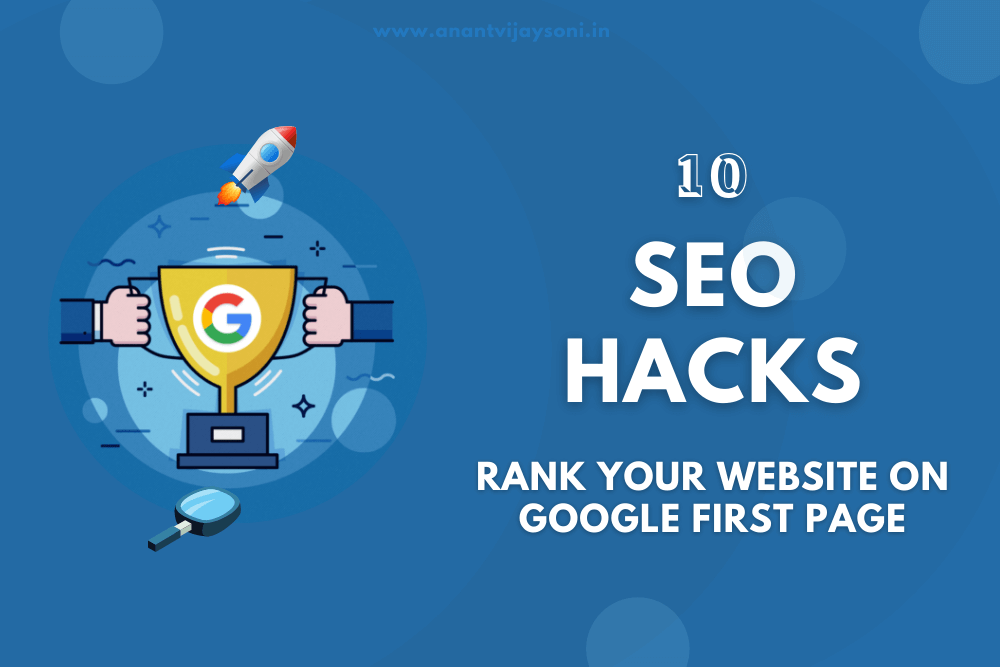The COVID-19-related shopping disruptions have sent digital marketing into a new era, the landscape of search engine optimization in 2024 is unlike anything it has ever been. By 2025, eCommerce sales will rocket from 19.1% to 33% as mobile shopping dominates online retail and user experience becomes an important ranking factor.
Today's business environment is dynamic and highly competitive, and businesses face both challenges for growth and technological setbacks, as they strive to adapt to the consumer market. With Google's 78 percent market share and 3.5 billion searches every day, putting yourself at an advantage means following the rules of Google better than your competitors.

Here are 10 Awesome SEO Hacks & Techniques that will help you to rank on the first page of google.
Table of Contents
10 SEO Hacks (2024)
1. Look at how the keyword research strategy works
In order to write content that is optimized for online audiences, keyword research has always been essential. Your business goals and the users' intent are the links between a good keyword research strategy. Your marketing strategy should take into account audience, topic, and competition research in order to find the best match.
Is there a way to streamline the keyword campaign process so that your content will rank higher in Google? Identify which pages on your website are performing well, which ones might need improvement,
Audit your low performing pages for keywords and find the gaps in keywords that your competitors are already ranking for. Check for longtail keywords using Alsoasked or Google Keyword Planner.
Use keywords that are suggestive of the type of content you provide, have low competition difficulty and have potential. You can make your content stand out by analyzing organic results and using your copywriting skills.
2. Using the legal semantic indexing system (LSI).
Search engine giant Google has made advances in its ability to interpret content with multiple terms and understand the relationships between related queries over the past decade. This means that you shouldn't focus solely on your keywords. To provide users with the most relevant results for a particular search query, Google emphasizes semantic analysis, from synonyms to longtails.
Adding informative text to your user's desire and covering LSI keywords will encourage you to write more quality content. By providing more reasons for readers to stick around, also decreases the bounce rate. Your page would be more relevant to that search and its rankings would increase.
3. Updating your website's footer
The footer and sitewide links that webmasters may not think much about are really important for SEO. It was once considered a black hat technique to have external links within your footer. Today, they don't hold any value. Keeping these links internal might be a good practice, just in case.
Make sure you follow John Mueller's advice by interlinking and cross-navigating naturally.
Use it for contact information, call-to-action, sitemaps, terms of service, social media, site searches, and the latest blog entries. It is not impossible, however, to add evergreen content and top landing pages that deserve more exposure. Make your anchor text more descriptive following best keywords research practices, and optimize it. Long-term, it would increase traffic to your website.
4. Optimise outbound links
When you use outbound links from high authority websites, you can benefit your website in a number of ways. By using quality content on your website, you will increase the value and popularity of your content, as well as help you build a network for linking agreements.
In addition to building trust with your readers, it enhances your search engine rankings. You will also be able to earn higher rankings by being able to explain your content to Google. By linking older content to new content, you can improve internal linking. By aiding in authority-building, Pagerank distribution, and organic ranking, the process can also improve search engine visibility. As a result, your content is more likely to engage users, keeping bounce rates under control.
5. Repair broken Links
In addition to harming user experience, website performance, reputation, and revenue, broken links damage the reputation of a business. It is possible to discover them more easily with tools such as Dead Link Checker. Find a valid replacement for internal sources, or get rid of them entirely. In the absence of control, fixing broken external links is challenging. Putting links on authority websites will reduce the chances of this happening, but if it does, be sure to contact the owner of the website and take down the link.
Maintaining a healthy SEO routine involves crawling your website regularly and correcting broken links. Your site's performance will be adversely affected by the secondary effects these issues have.
6. Prepare for the revolution of voice search
It's right what you read. Using virtual assistants like Google, Siri, Alexa, or Cortana should account for 50% of all searches online by 2024.
As such, your content needs to focus on answering questions about your niche, products, and services in order to optimize for voice search.
The people also ask section in Google search and Answer The Public are online tools you can use to find these frequently asked questions.
7. The Great Search Intent
Its goal is to provide users with accurate and prompt answers. Therefore, creating content to match a user's search intent is essential for 2024. Contrary to popular belief, content that doesn't match a user's search intent does not rank in SERPs.
When you target a keyword in your blog post, for instance, you have to understand the intent behind it.
What is the purpose of the research? What are you looking for? Maybe they're comparing products?
As a rule of thumb, the better your website caters to user search intent, the better it will rank.
Consider the term “smart camera”. They may be looking for information about security cameras, or they may simply want to buy something. As can be seen from this example, people searching for a “smart camera” are looking to purchase the device.
8. Utilize Rich Snippets
In a sea of competitors, would you like to stand out? You can make your listings more informative and unique by using rich snippets. The product information, ratings, and image are displayed in the snippet.
As a result, rich snippets help you increase your website's click-through rate by adding structured data markup to your site's HTML; this helps search engines better understand your site, allowing them to index your pages more accurately, and ranking you higher in search results.
Here is an example of what I mean. If you see a rich snippet in the search results, you're more likely to click it than if it shows mediocre results.
9. Updating existing content and publishing evergreen content
You've probably noticed by now that content is king in SEO. You would be better off focusing on producing evergreen content in 2024 and beyond that would be useful and relevant.
As your website gains momentum, you will automatically continue to attract new customers as time passes without even having to create new content continuously.
In addition, updating your existing content to match users' searches will help you turn them into evergreen content that will serve your business for a long time.
A website's evergreen content should include the following elements:
- How-to guides in-depth
- Your product or service case studies
- A customer's review of a product
- A list-based blog post
- Courses on tutoring
- Industry experts are interviewed
10. Optimize images on websites
According to this not-so-old saying, “people buy with their eyes.” Even if you're not publishing any sales content at the moment, images, especially long-form blog posts, are like eye-breathers for your website visitors.
In order to improve your search engine rankings, you should include images in your content.
To optimize your image for SEO, you need to keep the following things in mind:
- Using simple or plain language when naming your images
- You should name your images descriptively
- Search engines and those with visual impairments will be able to understand what the image is all about by using the alternative (ALT) attribute on the image.
- Compress your images to reduce their file sizes, so your website doesn't load slowly
These 10 SEO hacks and techniques will definitely help you to rank on the first page of google. For more articles like this visit World news in Hindi






One Comment
the nice article we need more articles this type and we need do-follow backlink pls give me.